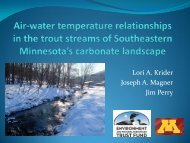Minnesota Water Resources Conference - Water Resources Center ...
Minnesota Water Resources Conference - Water Resources Center ...
Minnesota Water Resources Conference - Water Resources Center ...
Create successful ePaper yourself
Turn your PDF publications into a flip-book with our unique Google optimized e-Paper software.
Concurrent Sessions VI 3:00–4:30<br />
Track A: TMDL<br />
BOOK OF ABSTRACTS<br />
Wednesday, Tuesday, October 24 28 23<br />
<strong>Water</strong> Quality Data for Lake Nutrient TMDLs: How Much is Enough<br />
Rebecca Kluckhohn, Wenck Associates, Inc., rkluckhohn@wenck.com; Merle Anderson, Clearwater River <strong>Water</strong>shed District;<br />
Diane Spector, Wenck Associates, Inc.<br />
Current approaches to setting lake nutrient TMDL’s involve expensive data collection modeling efforts.<br />
This paper compares implementation plans developed for lakes using large and small data sets and asks<br />
the question: How different is a $5,000 Implementation Plan from $50,000 plan Due to pressure from<br />
lakeshore residents concerned over rapidly declining water quality in Cedar Lake, we used an Implementation<br />
Strategy Ranking System (ISRS) in conjunction with a small but robust set of data and tools to draft an<br />
implementation plan for the lake. The ISRS was used to understand the relative costs and uncertainty<br />
associated with each implementation strategy. Additional data was collected to reduce the uncertainty and<br />
refine the implementation plan; however the differences between the draft and final plans resulted mostly from<br />
stakeholder input and logistical limitations, not from a reduction in uncertainties afforded by the additional<br />
data. Lessons learned have implications for all TMDLs in <strong>Minnesota</strong>.<br />
Integrating Geomorphologic Field Assessment and <strong>Water</strong>shed Modeling for Turbidity TMDL<br />
Greg Johnson, <strong>Minnesota</strong> Pollution Control Agency, gregory.johnson@state.mn.us; Troy Naperala, URS Corporation; Karen<br />
Evens, <strong>Minnesota</strong> Pollution Control Agency, Julianne Socha, USEPA<br />
The Poplar River turbidity TMDL was developed using total suspended sediment (TSS) as a numeric target.<br />
Sediment sources were quantified by analyzing water quality data, a physical channel assessment and computer<br />
modeling. Results of the data analysis indicated that: 68% to 85% of the TSS was originating in the lower Poplar<br />
River watershed; 73% of the turbidity exceedances occurred during high flow, and; 55% of the TSS reached the<br />
stream during April and May.<br />
The results of the physical channel assessment and WEPP computer modeling showed that:<br />
■■<br />
■■<br />
■■<br />
■■<br />
■■<br />
Near stream land slides contributed 428 to 1,024 tons/ year;<br />
Gullies and ravines contribute 50 to 400 tons/ year;<br />
Disturbed lands (ski runs, roads, trails) contributed 330 to 990 tons/ year;<br />
Forest land contributed 140 to 421 tons/ year and;<br />
Other sources (channel incision, golf courses, and developed areas) contributed 38 to 140 tons/ year.<br />
<strong>Minnesota</strong> <strong>Water</strong> <strong>Resources</strong> <strong>Conference</strong>, October 27–28, 2008 76
















